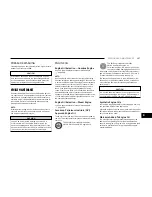
WARNING!
Do not connect the jumper cable to the negative
(-)
post of the discharged battery. The resulting electrical
spark could cause the battery to explode and could
result in personal injury.
5. Start the engine in the vehicle that has the booster bat-
tery, let the engine idle a few minutes, and then start
the engine in the vehicle with the discharged battery.
CAUTION!
Do not connect jumper cable to any of the fuses on
the positive battery terminal. The resulting electrical
current will blow the fuse.
6. Once the engine is started, follow the disconnecting
procedure.
Disconnecting The Jumper Cables
1. Disconnect the negative
(-)
end of the jumper cable
from the engine ground of the vehicle with the dis-
charged battery.
2. Disconnect the opposite end of the negative
(-)
jumper cable from the negative
(-)
post of the
booster battery.
3. Disconnect the positive
(+)
end of the jumper cable
from the positive
(+)
post of the booster battery.
4. Disconnect the opposite end of the positive
(+)
jumper cable from the positive
(+)
post of the
vehicle with the discharged battery, and reinstall the
protective cap over the positive
(+)
post.
If frequent jump starting is required to start your vehicle
you should have the battery and charging system
inspected at an authorized dealer.
CAUTION!
Accessories plugged into the vehicle power outlets
draw power from the vehicle’s battery, even when not
in use (i.e., cellular devices, etc.). Eventually, if
plugged in long enough without engine operation, the
vehicle’s battery will discharge sufficiently to degrade
battery life and/or prevent the engine from starting.
IF YOUR ENGINE OVERHEATS
If the vehicle is overheating, it will need to be serviced
by an authorized dealer.
Potential signs of vehicle overheating:
•
Temperature gauge is at HOT (H)
•
Strong smell of coolant
•
White smoke coming from engine or exhaust
•
Coolant bottle coolant has bubbles present
WARNING!
You or others can be badly burned by hot engine cool-
ant (antifreeze) or steam from your radiator. If you
see or hear steam coming from under the hood, do
not open the hood until the radiator has had time to
cool. Never try to open a cooling system pressure cap
when the radiator or coolant bottle is hot.
If the temperature gauge is moving towards or close to
the HOT (H) position, you can reduce the potential for
overheating by taking the appropriate action.
•
On highways — slow down.
•
In city traffic — while stopped, place the transmis-
sion in NEUTRAL (N), but do not increase the engine
idle speed while preventing vehicle motion with the
brakes.
•
Turn off the Air Conditioner (A/C). The A/C system
adds heat to the engine cooling system and turning
the A/C off can help remove this heat.
•
Turn the temperature control to maximum heat, and
the blower control to high. This allows the heater
core to act as a supplement to the radiator and aids
in removing heat from the engine cooling system.
CAUTION!
Driving with a hot cooling system could damage your
vehicle. If the temperature gauge reads HOT (H), pull
over and stop the vehicle. Idle the vehicle with the air
conditioner turned off until the pointer drops back
into the normal range. If the pointer remains on HOT
(H), and you hear continuous chimes, turn the engine
off immediately and call for service.
GEAR SELECTOR OVERRIDE
6-SPEED TRANSMISSION —
IF EQUIPPED
In order to move the vehicle in cases where the trans-
mission will not shift out of PARK (P) (such as a
depleted battery), a Manual Park Release is available.
1. Turn the engine OFF.
2. Firmly apply the parking brake.
IN CASE OF EMERGENCY
273
7
Содержание CHASSIS CAB 2024
Страница 69: ...GETTING TO KNOW YOUR INSTRUMENT PANEL MIDLINE INSTRUMENT CLUSTER GASOLINE 67 3...
Страница 71: ...HIGHLINE INSTRUMENT CLUSTER GASOLINE GETTING TO KNOW YOUR INSTRUMENT PANEL 69 3...
Страница 75: ...MIDLINE INSTRUMENT CLUSTER DIESEL GETTING TO KNOW YOUR INSTRUMENT PANEL 73 3...
Страница 77: ...HIGHLINE INSTRUMENT CLUSTER DIESEL GETTING TO KNOW YOUR INSTRUMENT PANEL 75 3...
Страница 357: ......
Страница 358: ......



































